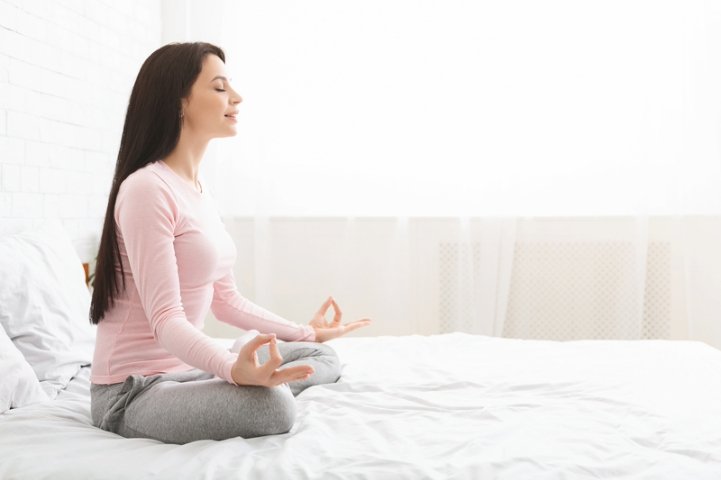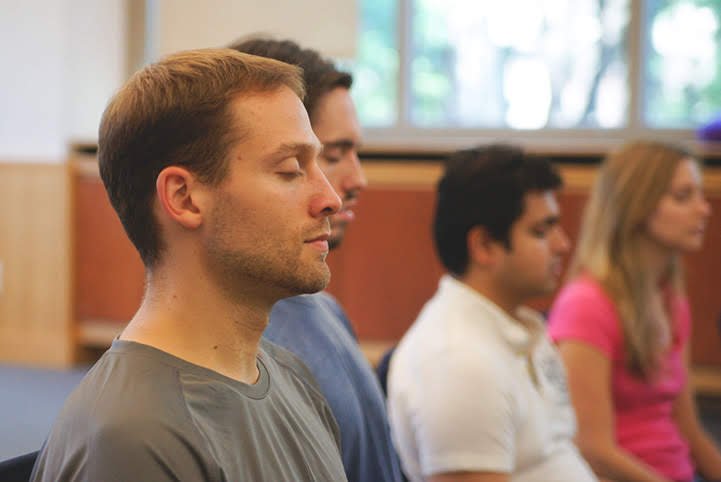
Beginners Guide
Discover an effective 10-minute meditation for quick stress relief and clarity. Take a moment for yourself and boost your well-being—read the article now!
Want to know something amazing? Just 10 minutes of daily meditation can significantly enhance your mental well-being.
Most people picture meditation as a practice involving darkened rooms, burning incense, and hours of sitting still. The truth is much simpler than that. Meditation’s history spans thousands of years. The practice boils down to breathing and awareness. A few minutes of meditation can restore your calm and inner peace.
Meditation might seem overwhelming at first. The good news? Anyone can do it. Research proves that meditation reduces generalized anxiety and depression. Your emotional well-being and overall health benefit from the sense of calm, peace, and balance it brings. Kindness-based meditation fosters greater compassion toward yourself and others. It also boosts your positive emotions.
Ten minutes of meditation provides enough time to center yourself and reap tangible benefits. This piece will show you how to build a simple meditation practice that works. You’ll learn to wash away your day’s stress and find inner peace, even with your packed schedule.

Ten minutes might not seem like much, but it’s the perfect amount of time to start your meditation experience. Research shows that even brief meditation sessions provide substantial benefits. This makes it an ideal starting point for those new to meditation and who feel intimidated by longer practices.
Science supports the effectiveness of short meditation sessions. Studies show that just 10 minutes of meditation helps reduce generalized anxiety and depression. People with PTSD sleep better because it reduces intrusive thoughts.
Research published in Psychological Science found that 15 minutes of meditation can boost decision-making abilities. A study also showed that 25 minutes of meditation over three consecutive days reduces stress levels.
Your consistency matters more than the duration of your meditation. One study revealed that 10 days of regular practice led to an 11% decrease in stress. This number jumped to 32% after 30 days. You’ll get better results from 5 minutes daily throughout the week than from a single 60-minute session once a week.
The full 10 minutes might feel like too much at first. Start with 3-5 minutes and add a minute every few days until you reach your goal. Tony Robbins put it best: “If you don’t have ten minutes, you don’t have a life.”
The right environment can significantly enhance your meditation experience. You need a quiet corner where no one will disturb you. A dedicated meditation room is great if you have the space, but all you really need is about 4 feet by 4 feet of floor space.
Your meditation space should include:
Keep your spine straight and eyes closed while sitting. You can choose these positions:
Pick a position that feels comfortable for the full 10 minutes. A meditation teacher explains, “The aim is to sit in a way that is comfortable for your body, and which also represents the attitude you want to carry inside as you meditate.”
This beautiful quote perfectly captures what happens during meditation. Your awareness spreads outward like a candle’s light, moving beyond immediate thoughts and concerns.
Your mind naturally broadens its perspective during meditation. This lets you observe your thoughts instead of getting caught up in them. An expert describes this process: “There is no good or bad meditation — there is simply awareness or non-awareness. To begin with, we get distracted a lot. Over time, we get distracted less”.
Setting aside just 10 minutes creates space for your mind to open naturally. Note that you should be “gentle with your approach, patient with the mind, and kind to yourself along the way” throughout your meditation experience.

Ready to start your meditation experience? You now understand why 10-minute sessions are most effective, so let’s take a closer look at the practical steps. A simple process will help you build a solid foundation for your meditation practice.
The right position plays a significant role in meditation success. Pick a quiet space where you can focus undisturbed for 10 minutes. Make yourself comfortable in a chair with feet flat on the ground, or sit cross-legged on a cushion. Your spine should be straight but relaxed—good posture helps your breathing flow while you stay relaxed.
Rest your hands on your lap or knees, and let your shoulders drop naturally. A slight chin tuck will lengthen your spine. This balanced position helps you remain alert yet relaxed during practice.
Your eyes should close gently to reduce distractions. You can lower your gaze and focus softly on a spot about a foot ahead if closing your eyes makes you uncomfortable.
Now that you’re settled, take a moment to notice your breathing. Don’t control or change it—just observe its natural rhythm. Feel the air moving through your nostrils, filling your lungs, and leaving your body with each exhale.
The air feels cool as you breathe in and warm as you breathe out. You might notice your chest rising and falling or your abdomen expanding and contracting with each breath.
Counting breaths can help deepen your focus: “1” on the inhale, “2” on the exhale, up to “10” before starting over. This gives your mind a clear point of focus, rather than allowing wandering thoughts.
Your mind will wander—it happens to everyone, and that’s perfectly normal. You’ll catch yourself thinking about your to-do list or yesterday’s conversation. Don’t get frustrated.
Acknowledge the wandering with a gentle mental note, such as “thinking” or “wandering.” Then, bring your attention back to your breath without judgment. Think of your thoughts as leaves in the wind—they naturally flow by, and you don’t need to hold onto them.
The goal isn’t to stop thinking but to notice thoughts without getting tangled in their stories. Each time you notice your wandering mind and return to the breath, your mindfulness grows stronger.
After a few minutes of breath focus, let your awareness expand to include your whole body. Start a systematic scan from head to toe (or toe to head) and pay attention to each body part.
Physical sensations will emerge, including warmth, coolness, tension, relaxation, heaviness, or lightness. Each major body part deserves about 20-30 seconds of attention. Breathe into tense areas and picture the tension melting away with each exhale rather than fighting it.
This helps you connect with physical sensations and emotions in your body. The practice teaches you to observe discomfort with curiosity instead of judgment.
As your session comes to an end, turn your thoughts to gratitude. Take a moment to consider what you’re grateful for—perhaps the chance to meditate, your health, your loved ones, or even the support of your chair.
A simple, silent phrase like “I’m grateful for…” completed with whatever comes naturally works well. This helps you transition smoothly from meditation back to daily life with positive energy.
Take three deep, mindful breaths to conclude your session. Open your eyes on the final exhale and notice how different you feel from when you started. This awareness of benefits helps strengthen your meditation habit.

Gurudev Sri Sri Ravi Shankar, founder of the Art of Living Foundation, adds a unique spiritual dimension to meditation. His approach elevates it beyond a simple practice into a deep journey of self-discovery. His teachings show that meditation surpasses technique—you simply need to uncover the peace already within you.
Meditation works best when we stop trying too hard, just like falling asleep. Gurudev teaches that peace moves further away the more we chase it. The mind resembles a wild horse that needs gentle guidance to its natural resting place rather than forceful restraint.
“Relax and let go of all your efforts,” advises Gurudev. A space for genuine meditation opens up when we stop our constant striving. This paradox—achieving more by doing less—remains the lifeblood of Gurudev’s meditation philosophy.
You must release all self-striving. The source of love and peace will embrace you afterward, as one practitioner notes. Without a doubt, authentic meditation begins the moment you stop trying to meditate.
Gurudev’s wisdom shines brightest in his approach to thoughts during meditation. He teaches us to welcome all thoughts without criticism or attachment, unlike methods that try to empty the mind.
“A helpful way of engaging in mindfulness of thoughts is thinking of them as clouds in the sky,” explains one of his guided meditations. “These clouds of thoughts are passing by. You watch them pass, but you don’t cling to them or attach to them.”
This practice strengthens what Gurudev calls “your witness within, your observer.” We foster greater intimacy with our inner world by accepting thoughts without judgment, understanding what truly occupies our minds and hearts.
Gurudev guides practitioners to expand their consciousness beyond personal boundaries once they establish non-judgmental awareness. His teachings explain that present-moment awareness offers a wonderful way to replenish and nourish ourselves on a daily basis.
We notice sensations as “pleasant, unpleasant, or neutral” during this expansion. Gurudev calls this “choiceless awareness”—we become aware of whatever dominates our consciousness without controlling or choosing it.
This profound statement encapsulates Gurudev’s fundamental teaching about the ultimate purpose of meditation. “God is not an object of senses but the feeling of feelings, the presence of presence, the sound of silence, the light of life, the essence of the world, and the taste of bliss,” he explains.
Meditation connects us with the divine that pervades everything, according to Gurudev. “God is the very core of your existence. The Divine Principle is not someone in the sky; it is inside you in the form of consciousness,” he teaches. Regular 10-minute meditation practice helps us recognize this divine presence within and around us.

Do you need some simple resources to support your meditation practice? The right tools can make all the difference once you understand the simple concepts and Gurudev’s wisdom. You’ll find several resources that work great for meditation beginners.
Research shows that short, regular practices create remarkable results. A single session of guided 10-minute meditation can reduce mind-wandering by 15%. The practice for 10 days decreases irritability by 27%. Your stress levels drop by 32% after 30 days of practice.
A perfect 10-minute meditation focuses on your breath. You notice your wandering mind and bring your attention back without judgment. Your “meditation muscle” gets stronger each time you return to your breath.
A detailed beginner’s guide takes you through the main meditation steps. You learn to find a quiet space, set a reasonable time limit (5-10 minutes works best), notice your body position, and follow your breath.
Meditation teacher Sharon Salzberg puts it well: “The most important moment in your meditation practice is the moment you sit down to do it, because right then you’re saying to yourself that you believe in change”.
This well-structured program delivers clear results: 37% more calm within four weeks and 23% less anxiety within six weeks. The three-day program covers desktop yoga, breathing techniques, meditation, healthy diet tips, and practical wisdom for daily life.
Sudarshan Kriya™, the lifeblood technique, changes your breathing patterns and transforms your emotional state. Yale University research confirms that people experience better mental health, social connections, positive emotions, and lower stress levels.
These resources provide structured pathways to develop your practice. You can choose between self-guided sessions or more detailed programs.

Mind wandering during meditation? You’re not alone—this happens to everyone, even experienced meditators. The way you handle distractions can become one of the most valuable aspects of your meditation practice.
Our minds naturally produce thoughts—that’s what they do best. Your 10-minute meditation will show you this firsthand. Thoughts about plans, problems, or random memories might pop up. This wandering doesn’t mean you’ve failed; it gives you a chance to grow and learn.
The most enriching part of learning meditation comes from spotting when your mind wanders. Your awareness grows stronger each time you catch your attention drifting. Picture your thoughts as leaves floating down a stream—notice them without holding on.
These distractions might show up as:
Your attention will stray, and that’s okay. Guide it back to your breathing, soft and gentle. The word gently matters here. Don’t force your attention back or blame yourself. You may need to return to your breath dozens of times during your 10-minute session—that’s perfectly fine.
Your breath works like an anchor, ready to help you refocus on the present moment. Some people find it helpful to count their inhalations and exhalations quietly to stay focused.
Show kindness to yourself during meditation. A non-judging attitude helps reduce daily stress and anxiety. Your mind might judge (“This isn’t working” or “I can’t focus”)—just see these as passing thoughts without acting on them.
A perfectly still mind isn’t the goal of meditation. The practice helps you notice your mind’s natural patterns when you pay attention. Your mindfulness grows stronger each time you wake up from mind-wandering and return to your breath.
A meditation teacher once said, “It’s not a bad sit. It’s just a revealing one in its own particular way.” Regular practice will help you notice distractions and refocus more naturally.

Meditation ranks among the most widely practiced wellness activities today. This article demonstrates how a daily 10-minute practice can lead to profound changes in our mental health and overall well-being. The real beauty lies not in getting everything perfect but in showing up for yourself day after day.
Your mind will wander—it happens to everyone. Each time you notice and gently return to your breath, you build your meditation muscle. The teachings of Gurudev Sri Sri Ravi Shankar show us we shouldn’t force the process. Meditation works best when we let go of effort and allow ourselves to just be.
A meditation trip brings rewards way beyond those 10 minutes on your cushion. You may notice improved focus during work, increased patience with loved ones, and a deeper sense of calm during life’s challenges. Research proves these benefits aren’t just in your head—they create measurable changes in your brain and body.
People often skip meditation because they think they don’t have time or the skill. In spite of that, Tony Robbins put it perfectly: “If you don’t have ten minutes, you don’t have a life.” Your practice should be simple. A quiet space, a comfortable position, and your breath provide everything you need to begin.
The divine presence that Gurudev describes—found in earth, air, fire, water, and within you—becomes clearer through regular practice. Today serves as your invitation to find this presence through meditation. You’ve already taken the most important step by starting, whether you choose guided sessions, workshops, or quiet breathing for a few minutes.
Your meditation path will have highs and lows, moments of clarity interspersed with distractions. Give yourself the same compassion you’d offer a close friend throughout this process. Meditation isn’t about perfection—it’s about awareness, presence, and connecting with your inner peace.
Those 10 minutes today could make all the difference. Your future self will thank you.

You’ve learned the basics—now take your meditation to the next level. The Art of Living Part 1 Course teaches Sudarshan Kriya, a simple yet deeply effective breathing practice that brings clarity, peace, and energy, not just during meditation, but throughout your day.
Whether you’re a beginner or just ready for more, this course gives you the techniques, guidance, and support to make calm your new normal.
🧘♂️ Go beyond 10 minutes—build a life of balance and ease.
👉 Find your course and unlock the power of your breath.












